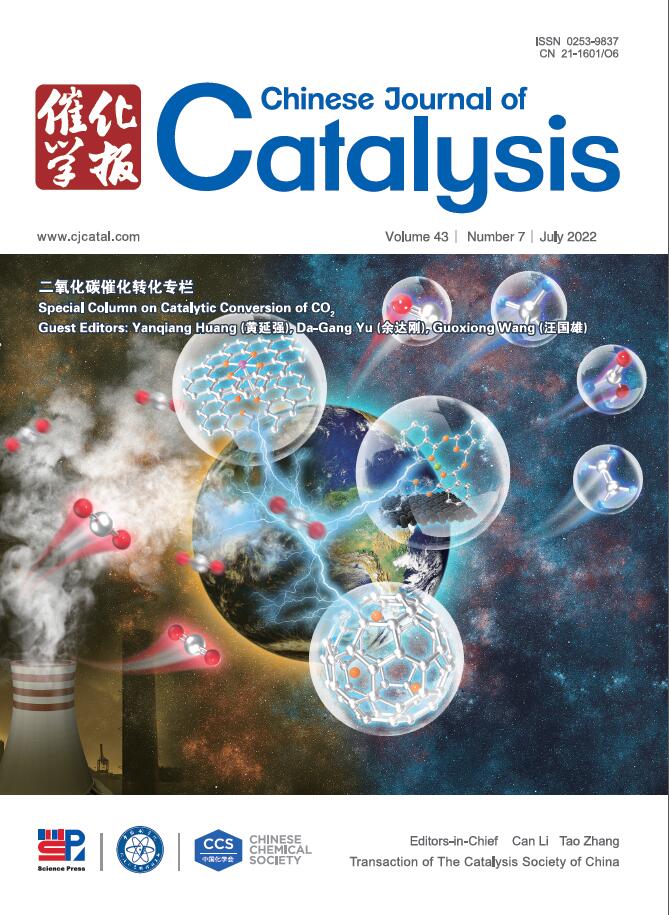In-situ distortion of Bi lattice in Bi28O32(SO4)10 cluster boosted electrocatalytic CO2 reduction to formate
IF 17.7
1区 化学
Q1 CHEMISTRY, APPLIED
引用次数: 0
Abstract
To convert carbon dioxide into high-value-added liquid products such as formate with renewable electricity (CO2RR) is a promising strategy of CO2 resource utilization. The key is to find a highly efficient and selective electrocatalyst for CO2RR. Herein, clustered Bi28O32(SO4)10 was found to show a high formate Faradaic efficiency (FEformate) of 96.2% at –1.1 VRHE and FEformate above 90% in a wide potential range from –0.9 to –1.3 VRHE in H-type cell, surpassing the corresponding layered Bi2O2SO4 (85.6% FEformate at –1.1 VRHE). The advantageous CO2RR performance of Bi28O32(SO4)10 over Bi2O2SO4 was ascribed to a special two-step in-situ reconstruction process, consisting of Bi28O32(SO4)10 → Bi–2.1/Bi2O2CO3 → Bi–2.1/Bi–0.6 during CO2RR. It gave metallic Bi–2.1 with lattice distortion of –2.1% at the first step and metallic Bi–0.6 with lattice distortion of –0.6% at the second step. In contrast, the usual layered Bi2O2SO4 only formed metallic Bi–0.6 with weaker lattice strain. The metallic Bi–2.1 revealed higher efficiency in stabilizing *CO2 intermediate and reducing the energy barrier of CO2RR, while suppressing hydrogen evolution reaction and CO formation. This work delivers a high-performance cluster-type Bi28O32(SO4)10 electrocatalyst for CO2RR, and elucidates the origin of superior performance of clustered Bi28O32(SO4)10 electrocatalysts compared with layered Bi2O2SO4.
Bi28O32(SO4)10簇中Bi晶格的原位畸变促进了电催化CO2还原生成甲酸盐
利用可再生电力(CO2RR)将二氧化碳转化为甲酸盐等高附加值液体产品是一种很有前途的二氧化碳资源利用策略。关键是找到一种高效、选择性的CO2RR电催化剂。本研究发现,簇状Bi28O32(SO4)10在-1.1 VRHE下具有96.2%的甲酸法拉第效率(fe甲酸),在-0.9至-1.3 VRHE范围内具有90%以上的甲酸法拉第效率(fe甲酸),超过了相应的层状Bi2O2SO4 (-1.1 VRHE下85.6%的fe甲酸)。Bi28O32(SO4)10优于Bi2O2SO4的CO2RR性能归因于在CO2RR过程中Bi28O32(SO4)10→Bi-2.1 /Bi2O2CO3→Bi-2.1 / Bi-0.6的特殊两步原位重构过程。第一步得到晶格畸变为-2.1%的金属Bi-2.1,第二步得到晶格畸变为-0.6%的金属Bi-0.6。而通常的层状Bi2O2SO4只形成金属Bi-0.6,晶格应变较弱。金属Bi-2.1在稳定*CO2中间体和降低CO2RR的能垒方面表现出较高的效率,同时抑制析氢反应和CO生成。本文制备了一种高性能的簇状Bi28O32(SO4)10电催化剂用于CO2RR,并阐明了簇状Bi28O32(SO4)10电催化剂性能优于层状Bi2O2SO4的原因。
本文章由计算机程序翻译,如有差异,请以英文原文为准。
求助全文
约1分钟内获得全文
求助全文
来源期刊

Chinese Journal of Catalysis
工程技术-工程:化工
CiteScore
25.80
自引率
10.30%
发文量
235
审稿时长
1.2 months
期刊介绍:
The journal covers a broad scope, encompassing new trends in catalysis for applications in energy production, environmental protection, and the preparation of materials, petroleum chemicals, and fine chemicals. It explores the scientific foundation for preparing and activating catalysts of commercial interest, emphasizing representative models.The focus includes spectroscopic methods for structural characterization, especially in situ techniques, as well as new theoretical methods with practical impact in catalysis and catalytic reactions.The journal delves into the relationship between homogeneous and heterogeneous catalysis and includes theoretical studies on the structure and reactivity of catalysts.Additionally, contributions on photocatalysis, biocatalysis, surface science, and catalysis-related chemical kinetics are welcomed.
 求助内容:
求助内容: 应助结果提醒方式:
应助结果提醒方式:


